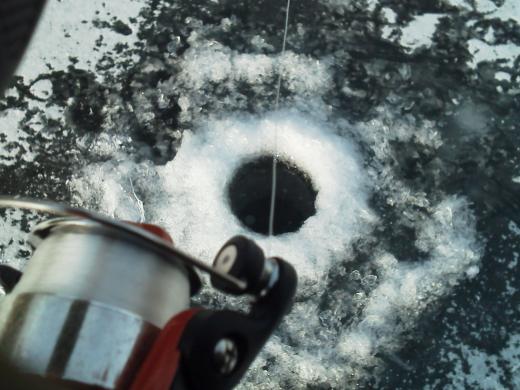ICE FISHING
"Flag!," my dad shouted. I looked up at my six tip-ups; one showed small piece of red cloth waving above it. I shuffled across the slippery ice at a brisk pace. When I got to the tip-up, the flag was still waving at the end of its thin, springy steel mast. Looking down into the hole and line was peeling off the spool. The white line was moving to my right. The underwater reel continued to turn at a steady rate. “It's moving!" I shouted. I stuffed my gloves into my pockets, reached down, lifted the tip-up and placed it on the ice next to the hole while feeding out more line.
Then the line lay motionless in the clear, cold water. I jerked the line. It jerked back.
"Fish on," I yelled. I pulled in four or five feet using a hand-over-hand retrieve. The fish resisted. The line had a constant tugging at the end of it. It took a couple of minutes to work the fish to the opening in the ice. When the fish was in sight, I used one continuous pull and lift motion and lifted it out of the hole. The large pickerel had its mouth open bearing many sharp teeth. It landed on the ice floppying around. Its eighteen inches of green and white sides gleamed in the sunlight as it lay next to the hole. It was the first of several fish that came from beneath the frozen surface of Congamond Lake that wintry day.
I have fished through the ice for more than 60 years on frozen surfaces ranging from small ponds to large lakes. I continue to enjoy this winter sport, although much of the equipment used today has been improved. What is the same is standing outdoors on frozen water during winter weather and conditions.
Here’s a brief history of the equipment I and other old timers have used. I started with making holes in the ice by chopping ice a long-handled ice chisel. That was the most difficult way to make holes. Then I used several different types of hand-powered augers, which drilled holes from 4” to 8”. Later I used was a gasoline-powered auger with a 10” cutting blade. I bought it used from the late George Kotsaftis who was a fishing companion of mine. It was a brute. It was heavy. It was loud. And had a gasoline odor when it was transported in my van. If you didn’t plant your feet into the ice, the torque could spin you around.
When I reached my senior years, enough was enough. I purchased an electric powered auger that has a small, built-in battery when fully charged will drill scores of holes. It’s light, quiet and no gas fumes.
After holes were made, the ice chips and shavings had to be cleared from the hole. If not, the hole would freeze over more quickly; it was more difficult to get the live bait into the water below the ice. The tool used was an ice skimmer. The early models were made of metal, had a 12”-16” handle and a scoop with small holes made of galvanized metal. Later models were made of polyethylene.
The third thing needed was tip-ups. In Connecticut anglers are allowed to use a maximum of 6 tip-ups. A combination of less tip-ups, bobbers and jigging rods cannot exceed six. After the holes are cut and cleared and tip-ups ready, the hooks need to be baited. Live shiners or other species of baitfish should be lively. So, one needs a bait bucket. There are a variety of bait buckets available today. One should use a minnow dipping net to get the bait out of the bucket. Anglers should minimize handling live bait so not to injure them. I rarely carried the bait bucket from hole to hole. In the early years, we would place several shiners in a clean Crisco can, to which a handle was added, then filled it with water. When a flag went up, the anglers carried the lightweight can to the hole.
Today, anglers fishing through the ice use all kinds of equipment to make holes and clear them. There are a variety of tip-ups and jigging rods available. Some anglers use LCD Fish Finders to locate fish and a few use underwater video cameras. There are many imitation baits and scores of lures/baits that jiggers use. Portable ice shelters are not popular in Connecticut, but each winter a few more are seen on the ice. Fishing through the ice is a winter sport that some people believe cures Cabin Fever.
by Bob Gregorski

